
13 minute read
COVER: TENET
IN-CAMERA MAGIC HELPS TENET SLIP THE BONDS OF TIME
By KEVIN H. MARTIN
All images courtesy of Warner Bros. Pictures.
TOP: Enigmatically identified only as ‘The Protagonist,’ John David Washington’s character is one of the agents tasked with averting a global disaster in Tenet.
OPPOSITE TOP: John David Washington is aided by Robert Pattinson. “Even after reading the script four times, I was still working out the complexities of it,” Tenet Visual Effects Supervisor Andrew Jackson admits. “Tenet was a case of just when you think you’ve gotten things clear in your mind, then you catch yourself and realize, ‘Oh no!’ And so you’ve got to think a bit harder. It’ll keep audiences wondering to work things out.”
Tenet is writer/producer/director Christopher Nolan’s latest thrill ride, shot almost entirely using 65mm and IMAX film cameras. The premise – featuring spies combating a mysterious global threat and the use of time inversions – has characters facing confounding visual contradictions that leave them wondering if they are coming or going. Starring John David Washington [his character enigmatically only identified as ‘The Protagonist’], Robert Pattinson and Kenneth Branagh, Nolan’s return to technothriller territory a la Inception boasts James Bond-sized full-scale set pieces while not stinting on effects magic – though with the focus primarily on in-camera work. Editor Jennifer Lame estimates only 300 VFX shots in the whole picture, while director Nolan says the level of VFX – created at DNEG, which has worked on Nolan’s films since Batman Begins in 2005 – is less than what would be found in most romantic comedies.
Visual Effects Producer Mike Chambers began working with Nolan on Inception. “With Chris being the writer/director/ producer he is, you can be sure after doing several shows with him that he knows not only what he wants but also how he would prefer to have things done,” Chambers says. “He’s very tech-savvy
with all aspects of production, and sees VFX as just one tool in the toolbox. He has always been happy with DNEG and likes the idea of avoiding multiple vendors unless something unusual comes up. Organizing early on for a Nolan project starts with knowing the ideal is to get as much in-camera as possible, but then to plan alternate routes that can get us to where we need if in-camera approach doesn’t get us all the way.”
For Jackson, an Oscar nominee for George Miller’s Mad Max: Fury Road and aveteran of the filmmaker’s Dunkirk, Tenet offered a chance to participate on a level deeper than the norm. “One of the best parts of working on a Nolan movie,” he reveals, “involves getting into essential aspects of storytelling and filmmaking problem-solving, going well beyond traditional visual effects concerns. We go into Chris’ films with the view of filming as much as possible in-camera. Sometimes those attempts are used as elements for a visual effects shot or even just as reference, and others survive into the final even without enhancement. I come from a practical effects background, having run that kind of business. It is part of my roots, so to speak, and I really love working with the physical effects unit.”
Jackson’s SFX counterpart Scott R. Fisher’s ongoing association with Nolan dates back a full decade to Inception. “Collaborating with Scott made for a very successful association,” Jackson reports. “We could talk things out while speaking the same language, then determine which processes might prove viable. Then it might be a matter of getting the art department and stunts, or some
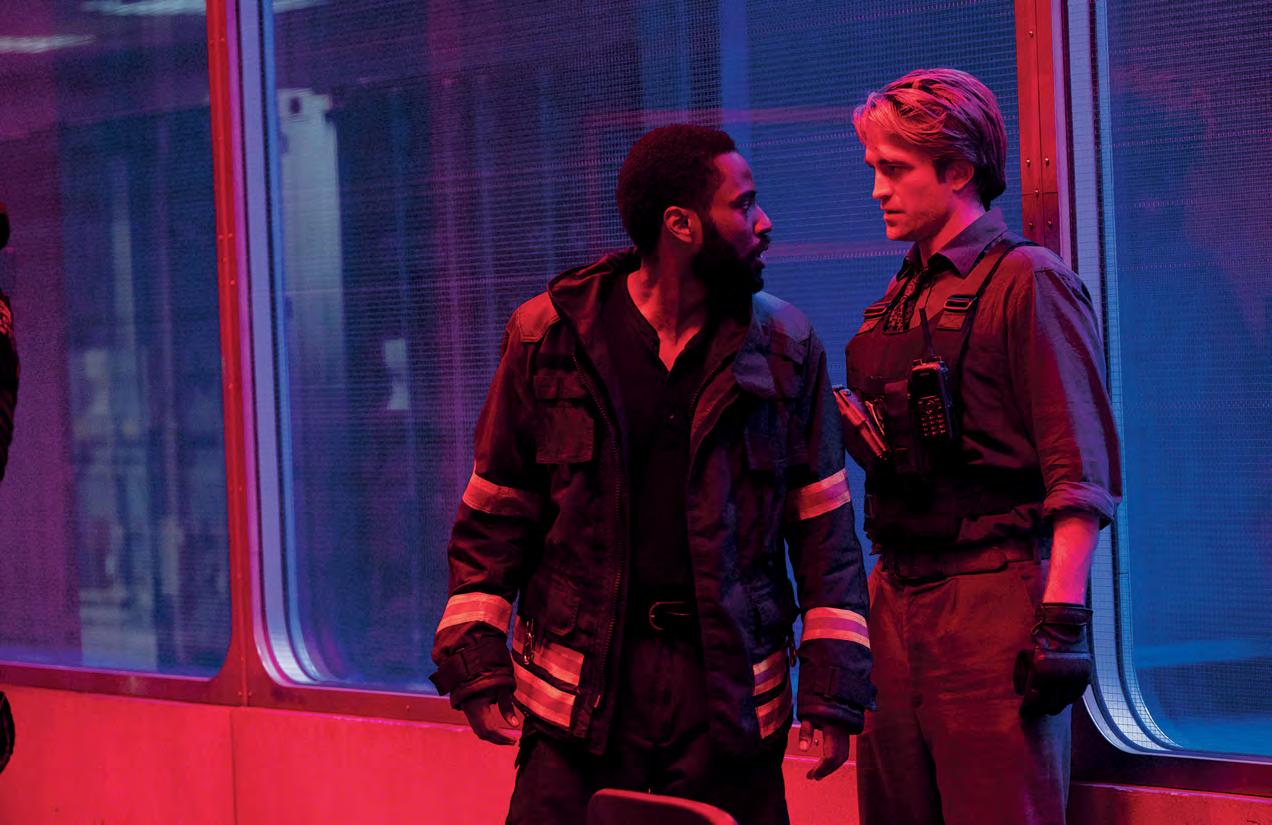
“With Chris being the writer/director/producer he is, you can be sure after doing several shows with him that he knows not only what he wants but also how he would prefer to have things done. He’s very tech-savvy with all aspects of production, and sees VFX as just one tool in the toolbox. He has always been happy with DNEG and likes the idea of avoiding multiple vendors unless something unusual comes up. Organizing early on for a Nolan project starts with knowing the ideal is to get as much in-camera as possible, but then to plan alternate routes that can get us to where we need if in-camera approach doesn’t get us all the way.” —Mike Chambers, Visual Effects Producer

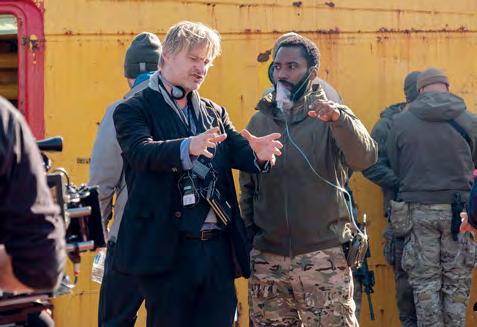
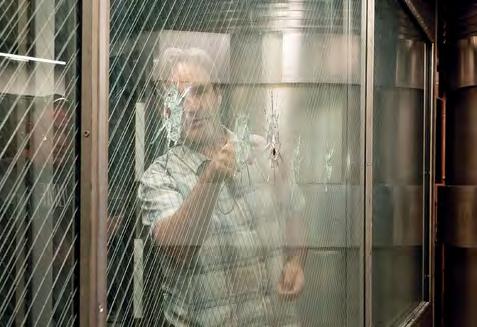
TOP: John David Washington and Elizabeth Debicki.
MIDDLE: Tenet marks a return on filmmaker Christopher Nolan’s part to sci-fi technothriller territory a la his Inception. As is his preference, in-camera effects were employed whenever possible.
BOTTOM: Special Effects Supervisor Scott Fisher inspects his department’s bullet hits. Achieving such matters practically on set is less and less common on other productions where the speed of shooting prohibits time to reset and leaves such effects for post. (Photo: Melinda Sue Gordon) departments, in the room for additional input. The synthesis of ideas and experience when you’ve got three or four departments all teaming up is very enjoyable for me to be a part of.”
Fisher’s long-held dictum for what he calls ‘special effects 101’ meshed with that of Nolan and Jackson. “You need to think like a magician,” he states. “If you use the same trick over and over, the audience will get wise and figure you out. So things need to keep changing up. Chris obviously feels the same way, so you try to achieve a similar look with different methodologies, which can span from practical effects to CGI to model work.
“When you break down a script for a Chris Nolan movie, it’s a different process than when you work on any other film,” he continues. “There are aspects that for anybody else, the default solution today would be to go CG, but that’s not necessarily the case with Chris – almost the opposite is true, which I find refreshing and exciting and really gives me and everyone in my crew a sense of challenge. In this day and age, there is so much effects being done as VFX is the go-to mindset, I couldn’t be in a better spot with a more willing boss than Chris when it comes to practicing my craft properly, getting the time to do all these tests and get things right for the camera.”
Fisher learned his craft alongside his father, Thomas L. Fisher, who he assisted on Terminator 2: Judgment Day. “I think part of what puts me in a good spot today relative to some other SFX guys is because of my experience during that era when the work was very well-integrated, before post could be considered viable for delivering enough of the appropriate look,” he observes. “What’s nice now is that the factor of newer technologies can enhance practical effects approaches, letting us raise the bar when doing many of the things we used to do back in the ’90s, but in bigger ways, with much greater control, including repeatability.
“On a film like Bumblebee,” Fisher states, “I know my role is going to be more limited, though you still try to offer options to enhance what is achieved on set, or can provide some interactivity that will help the CG integrate. When I did X-Men: First Class, there was a scene with two bullet hits on the beach. Director Matthew Vaughan thought it would take forever to get them done practically and indicated he would leave it for CG. I told him, ‘If you think I can’t rig two bullet hits right away, you should fire me. If you don’t like the results and don’t want take two, I’ll understand, but let me at least try.’ Maybe he had a film where they had some bad luck, or there was a lazy effects guy who didn’t offer up a practical solution, but offering options that save money and time and look better is a big part of the job for me.”
Involving Jackson at an early stage allowed him to weigh in and suggest ideas that helped with realizing Nolan’s preference to do the shots in-camera if possible or as a simple composite, only resorting to CG when absolutely necessary. Jackson breaks down the general thrust of pre-production planning as follows. “The hierarchy of work preference is pretty straightforward. Number 1: Get it shot in-camera. Number 2: If you can composite two practically-shot elements with minimal intervention, that’s the next best ideal. Then as you go down the line, there’s always some kind of full-on CG VFX solution – which we do have to utilize a certain
amount of the time – but it isn’t the first solution we look to.”
Jackson finds Nolan’s working style unique in the modern film world. “It’s certainly apart from any other high-end Hollywood movie,” he acknowledges, “and it is interesting to me that while he focuses on some aspects with extreme detail, others don’t concern him at all. I found myself worrying about certain bits on Dunkirk, but it turned out his instincts to ignore those were correct, so this time I’m settling in more with thinking the way he does, feeling more tuned into his processes, which has made for a very enjoyable shoot. There are scenes in the film where some of the action is seen happening backwards as the main characters are continuing ahead. It was a major challenge to figure out how to shoot this and get the forwards/backwards parts to live together in the final. That occupied a lot of time for the on-set VFX team, figuring out what we could film [with a camera running in reverse] versus what was impossible and would have to be created in post.”
The car chase is a prime example. “There was a technical previs, which used the computer to visualize aspects that would be more difficult to shoot,” Jackson clarifies. “The whole 3D animation toolset is very useful with these shots, as it lets you scroll right through a scene quickly in either forward or reverse to see how those parts fit together while testing the timing and beats of the events in a shot.”
More conventional VFX work was used on a scene featuring principals on a sailing yacht sporting a hydrofoil. “There were issues with getting the cast members on an actual working boat, which is the equivalent of being on a Grand Prix racer,” says Jackson. “So we did some shots with the real actors on the boat as it was towed, with no sail on it. Then we added the rigid sail, which was like a wing, as a full CG element. For shots of the real boat with a regular crew operating it at sea, we did face replacements, putting our actors’ features over the guys doing the work. Then, for the opera house, we had to do a comp to put people in the audience beneath an explosion, because it wouldn’t have been safe otherwise. There are films where an issue of safety arises where VFX needs to create a CG character to stand in for the performer, but that is really the exception to the rule with Chris’ films.”
Fisher’s end of the opera house scene, which was shot in Estonia, involved extensive testing for blowing out the windows. “It was an unused location, which sounds like a good candidate for film work,” he reports. “But it was also a local landmark, so we couldn’t just do whatever we wanted and just restore it afterwards. We knew there was a significant potential fire hazard, so that meant doing a lot of testing and cleaning, removing dust. Then, for the big jet plane scene, production built a set around an available plane, and our end involved towing it and achieving a control system for starting and stopping it in a repeatable and safe fashion.”
While Nolan had initially thought the plane crash would involve model work, that not-quite-lost art did feature in aerial scenes. “We built all those model planes for Dunkirk,” recalls Fisher, “which involved me digging up a lot of guys to do those miniatures and then to fly them with remote control. Nobody ever questions those shots, because they looked good and moved credibly, so going that route again for the Tenet helicopters made good sense.”
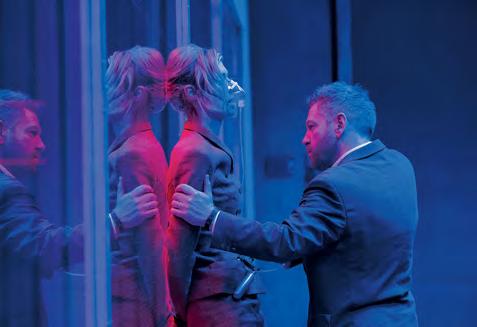

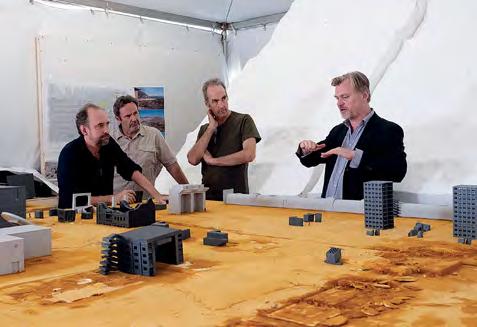
TOP: Elizabeth Debicki and Kenneth Branagh.
MIDDLE: The car chase required a technical previs in order to work out the various beats and storypoints. DNEG’s 3D animation toolset facilitated planning of forward and backward action for the reversed time moments.
BOTTOM: Christopher Nolan, Visual Effects Supervisor Andrew Jackson, Fisher and Production Designer Nathan Crowley block out the plane crash sequence with a tabletop model. (Photo: Melinda Sue Gordon)
“What’s nice now is that the factor of newer technologies can enhance practical effects approaches, letting us raise the bar when doing many of the things we used to do back in the ’90s, but in bigger ways, with much greater control, including repeatability.” —Scott R. Fisher, Special Effects Supervisor
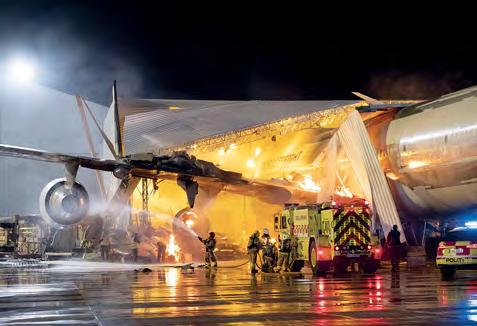


Jackson’s team helped Fisher with the construction of these large-scale models, which – along with the occasional CG copter – augmented production’s four actual Chinooks. “The flying R/C miniatures didn’t wind up in too many shots, but there are some very nice ones,” he states. “I was operating them from another boat as they seemed to be hovering over a real full-sized seagoing vessel. It was all forced perspective, with the models lined up in the foreground.”
With a post-production workflow that eschews the digital intermediate process in favor of a photochemically-timed finish, Nolan’s films utilize actual filmouts from VFX vendors. “For his post pipeline, we output the negative, and that gets color-timed and cut in with the rest of the film,” Jackson explains. “Also, Chris prefers to avoid scanning negative except when absolutely necessary. So, as was the case on Dunkirk, we again didn’t use any bluescreen or greenscreen, and didn’t have to remove tracking markers, which is definitely preferable from his point of view. There’s still a fair amount of roto, including incidental cleanup of rigs. For example, that was pretty much all of our end of things on the jumps and ascents done on the building in Mumbai.” [Stunt coordinator George Cottle built a structure on the outside of the building with computer-controlled winches that worked like motion-control to raise and lower the performers.]
While the scale of many modern blockbusters can seem daunting, the methods used to achieve these effects can vary the actual impact. “These days, moviegoers can become spoiled by all the spectacle, because there’s literally nothing you can’t create anymore in a big VFX-heavy film,” declares Jackson. “But viewers know things in Nolan films are being done for real. Seeing something done without our typical brand of trickery creates a sense of awe, harkening back to a different era.”
Fisher firmly agrees. “Chris has really integrated a sense of showmanship into his brand, so people expect a really big show, and he hasn’t disappointed yet. He gives people a desire and reason to go see movies on a big screen.”
Finishing on film has to date been an important ingredient to Nolan’s films. “That’s becoming harder to do given the lack of sustaining infrastructure,” Chambers relates. “He’s a believer in the theatrical cinema-going experience, trying almost single-handedly to keep it alive. The pandemic certainly impacted post for us and how we finish. Not detrimentally – since it didn’t hurt the quality of the final product – but in methodology. The million-dollar question right now is, how are we all going forward?”
TOP: Originally conceived as a showcase for miniatures, the plane crash effect was achieved using an actual jet plane, with destroyable buildings fabricated for its impact. (Photo: Melinda Sue Gordon)
MIDDLE AND BOTTOM: A large explosion devastates an opera house. Fisher executed various blasts for the interior and exterior views.











